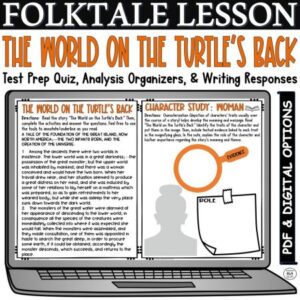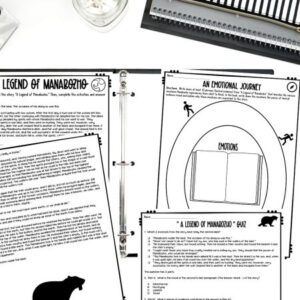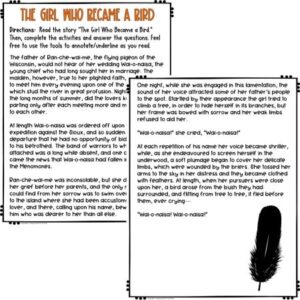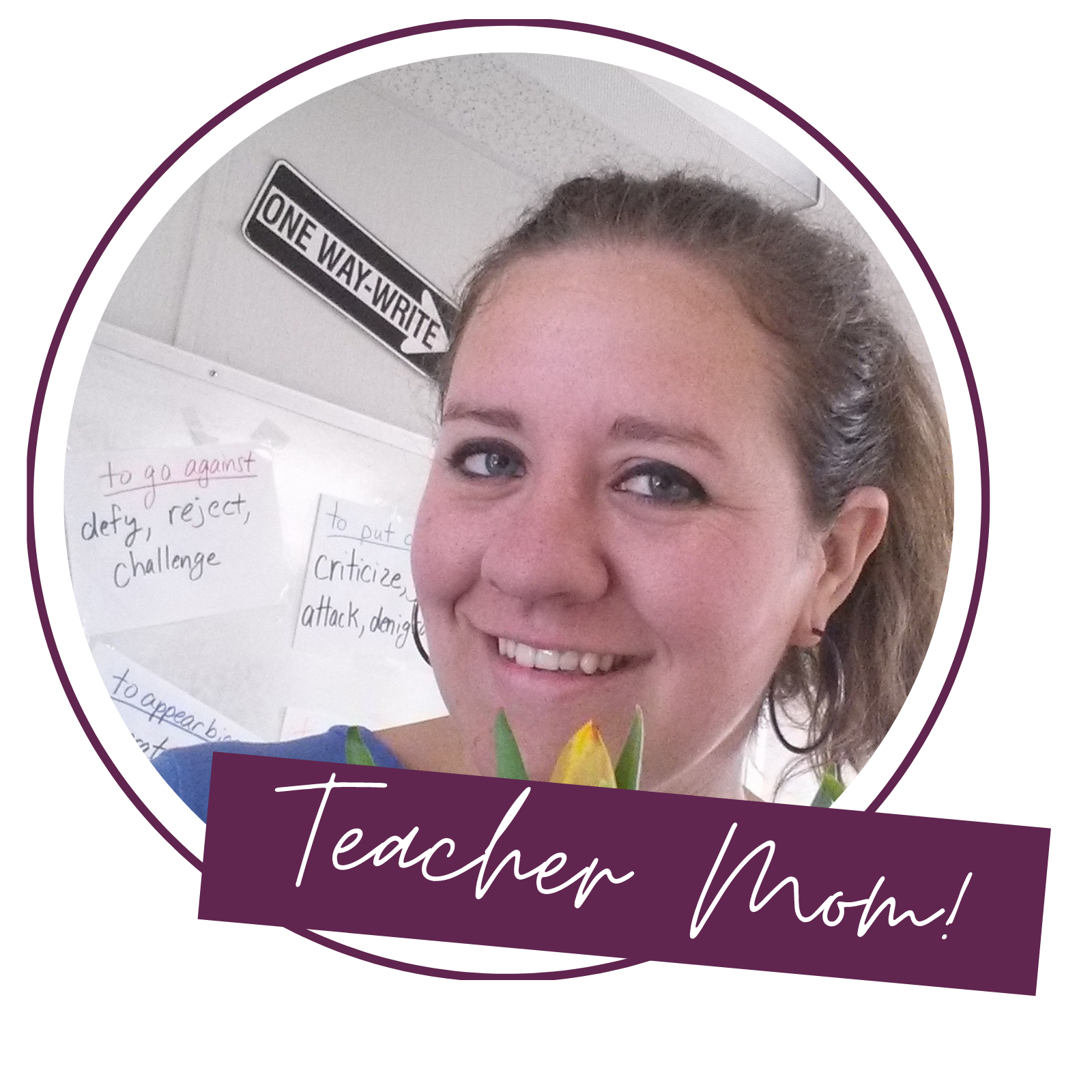When was the last time you taught folktales or myths in your English classes? I didn’t until I started teaching American Literature, and that is so incredibly unfortunate! When you include tales like Native American stories of creation into your curriculum, you expose students to more than the typical literary canon!
Most importantly, we get a glimpse into history most of us are unaware of, and that exposure is incredibly necessary, mainly because the United States is becoming more diverse every day!
So I encourage you to consider using two or more of the stories below! You will not regret it, and your students will enjoy them so much!
Keep reading for 5 Profound Native American Stories of Creation!
Need help with Test Prep? Check out this FREE Pack of 3 Test Prep Activities to help students achieve success on standardized tests!
Why Read Native American Stories of Creation?
Way too often, we trudge into American Literature by starting when the first European explorers arrived in America or when colonists entered the Revolutionary Period. Instead, I suggest beginning American Literature with Native American stories of creation!
They are relatively short, packed with imagery and details, and convey significant aspects of cultures that have often been forgotten over the last several hundred years! While students may not be religious or culturally aware, we need to help students understand that knowledge of history is vital to comprehending what is going on today!
See below for lessons and activity ideas for 5 Profound Native American Stories of Creation!
Want to teach one of the most significant American documents in history, but you don’t know where to start? See this post for help!
5 Profound Native American Stories of Creation
1. The World Upon the Turtle’s Back
Probably the most famous of Native American Stories of Creation, this version of “The World Upon the Turtle’s Back,” also known as “The Earth on the Turtle’s Back,” starts in this way:
Among the ancients there were two worlds in existence. The lower world was in a great darkness;—the possession of the great monster; but the upper world was inhabited by mankind; and there was a woman conceived and would have the twin born. When her travail drew near, and her situation seemed to produce a great distress on her mind, and she was induced by some of her relations to lay herself on a mattress which was prepared, so as to gain refreshments to her wearied body; but while she was asleep the very place sunk down towards the dark world.
Intriguing, right?? I want to know what will happen in both worlds! And what happens to the pregnant woman?
Ultimately, this story concludes with the death of the evil twin, and the good twin triumphs. Humans and animals get to continue to live and thrive in the world created and developed by the good twin!
LESSON IDEAS:
- Examine the characterization of the turtle, the woman, and the twins by focusing on at least 2-3 pieces of evidence linked to each.
- Write your own creation story in about 500 words with plot elements like exposition, rising action, climax, falling action, and resolution.
- Analyze the structure of the story and its effectiveness: How does the story start and end? How does the structure connect to the title?
- Break down the theme or message of the story. What is the story conveying about creation, life, and/or death? Answer in complete sentences.
- Ask comprehension questions by focusing on the central idea, repetition of specific words, and imagery. Require complete sentences for responses.
Get this lesson pack with PDF and digital options for the most taught tale in the category of Native American stories of creation!
2. A Legend of Manabozo
Your students will love reading Native American stories of creation, such as “A Legend of Manabozo,” because they often explore the timeless topic of revenge. Who doesn’t enjoy reading about revenge?
There are so many texts linked to revenge, like Edgar Allan Poe’s “The Cask of Amontillado” and “A Poison Tree’ by William Blake! See? Integrating literature with Native American stories of creation can be super simple!
Here is the first part of the story that sets the stage for Manabozho’s revenge:
Manabozho made the land. The occasion of his doing so was this.
One day he went out hunting with two wolves. After the first day’s hunt one of the wolves left him and went to the left, but the other continuing with Manabozho he adopted him for his son. The lakes were in those days peopled by spirits with whom Manabozho and his son went to war. They destroyed all the spirits in one lake, and then went on hunting.
They were not, however, very successful, for every deer the wolf chased fled to another of the lakes and escaped from them. It chanced that one day Manabozho started a deer, and the wolf gave chase. The animal fled to the lake, which was covered with ice, and the wolf pursued it. At the moment when the wolf had come up to the prey the ice broke, and both fell in, when the spirits, catching them, at once devoured them.
Without this introduction, we cannot fully understand the end of the story! See below for lesson ideas!
LESSON IDEAS:
- Teach character progression. How does the protagonist change throughout the story? What does he experience from start to finish? Use textual evidence to support your ideas.
- Visualize the major events in the story. By focusing on key events, we help students understand what is going on. Be sure to encourage students to identify evidence for each visual.
- Review mood (emotion created by the setting and events). This question has two parts. Part A: What is the mood of the second-to-last paragraph (The beaver dived…) of the story? Part B: What evidence supports the mood of that paragraph?
Get this story with a lesson and activities to last several days!
3. The Sun and the Moon
Defiance is a natural part of the human experience. For some reason, it seems built into us, and most teens can easily relate. This tale, “The Sun and the Moon,” is an unconventional addition to Native American stories of creation, and it is one of my favorites!
Below is the first part of this beautiful story:
There were once ten brothers who hunted together, and at night they occupied the same lodge. One day, after they had been hunting, coming home they found sitting inside the lodge near the door a beautiful woman. She appeared to be a stranger, and was so lovely that all the hunters loved her, and as she could only be the wife of one, they agreed that he should have her who was most successful in the next day’s hunt.
Accordingly, the next day, they each took different ways, and hunted till the sun went down, when they met at the lodge. Nine of the hunters had found nothing, but the youngest brought home a deer, so the woman was given to him for his wife.
I know! There are so many questions: 1) What happens to the wife? 2) What happens to the brothers? Why is the title called “The Sun and the Moon?”
Keep reading here for the rest of the story!
LESSON IDEAS:
- Define and identify plot elements like Exposition (introduction to the setting, characters, and conflict). Students need to be able to understand the impact of the beginning of the story on the rest of the story!
- Create a folktale comic strip by exploring a natural phenomenon: its creation, features, or interaction with something else. Ensure you use a plot structure with an Exposition, Rising Action, Climax, Falling Action, and Resolution, as well as dialogue and narration. Six or more images will help students develop their stories, and working with others may be helpful for students who struggle.
- Investigate vocabulary throughout the story. You might focus on context clues, synonyms, and antonyms. Here is an example: What synonyms might be appropriate for the underlined word in the excerpt below? She did not, however, love him, for he was of a churlish disposition, and one day it came into the woman’s head that she would leave him and see what fortune she would meet with in the world.
Click here to get the whole pack!
4. The Girl Who Became a Bird
“The Girl Who Became a Bird” fits into Native American stories of creation, as it illustrates how a bird’s characteristics developed when a girl defies her father. The tension is palpable, and the ending has a nice twist!
Check out this first paragraph from my favorite Native American stories of creation tale:
The father of Ran-che-wai-me, the flying pigeon of the Wisconsin, would not hear of her wedding Wai-o-naisa, the young chief who had long sought her in marriage. The maiden, however, true to her plighted faith, still continued to meet him every evening upon one of the tufted islets which stud the river in great profusion. Nightly, through the long months of summer, did the lovers keep their tryst, parting only after each meeting more and more endeared to each other.
Who wouldn’t be engaged immediately by reading this first paragraph? In fact, it provides a nice thematic connection to Romeo and Juliet! Thematic connections to Native American stories of creation and other texts are clear!
LESSON IDEAS:
- Dive into character traits: External (physical) and Internal (character/personality). First, make connections by asking students about their own traits.
- Track characterization of the girl in the story. What excerpts or sentences describe her? What do they reveal?
- Write an expository paragraph about the girl. How is she characterized, and how does this characterization contribute to the meaning or theme of the story? Use evidence to support your ideas.
Want two days of activities for this tale? See here!
5. The Journey to the Island of Souls
While not really one of the Native American stories of creation, this story relays a journey to heaven, an important motif of most tales of creation! And I am a sucker for love stories!
Here is the first chunk from “The Journey to the Island of Souls:”
Once upon a time there lived in the nation of the Chippeways a most beautiful maiden, the flower of the wilderness, the delight and wonder of all who saw her. She was called the Rock-rose, and was beloved by a youthful hunter, whose advances gained her affection. No one was like the brave Outalissa in her eyes: his deeds were the greatest, his skill was the most wonderful. It was not permitted them, however, to become the inhabitants of one lodge. Death came to the flower of the Chippeways.
In the morning of her days she died, and her body was laid in the dust with the customary rites of burial. All mourned for her, but Outalissa was a changed man. No more did he find delight in the chase or on the war-path. He grew sad, shunned the society of his brethren. He stood motionless as a tree in the hour of calm, as the wave that is frozen up by the breath of the cold wind.
I really like anything involving the supernatural, so Native American stories of creation or other myths like “The Journey to the Island of Souls” are my go-to literature!
LESSON IDEAS:
- Explain the term SETTING (description of time and place). Start by having students identify their favorite settings and use evidence to explain their choices!
- Follow the protagonist’s journey with a focus on the setting. Locate evidence for each new location, and analyze the setting’s impact on the mood, meaning, and/or message of the story.
- Extend the story. What happens to Outalissa? Does he ever love again? Use 2-3 paragraphs to finish his life story!
Use this Native American stories of creation pack with 2 days of activities!
Native American Stories of Creation Resource
Do you need engaging and relevant Reading Comprehension Passages and Questions that include Pre-Colonial Native American Stories of Creation? Check out this easy-to-teach bundle with 5 folktales that offer insight into the myths and legends of Early America! This 1-2 week PDF & Digital Resource Bundle contains reading and writing activities, 28 test prep QUESTIONS and ANSWERS, and detailed lessons! Give yourself a breath of fresh air with this NO PREP curriculum that integrates test prep into the teaching of Native American stories of creation!
Need more ideas for Native American Stories of Creation? Check out my store, Kristin Menke-Integrated ELA Test Prep!








